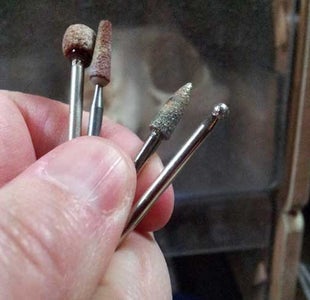Bone Carving Tutorial: Dremel Advice
Intro: Bone Carving Tutorial: Dremel Advice
The home of this tutorial can be found: here.
It is a question often asked of me: how do you stop the dremel, a powerful rotary tool you can use for carving, from digging in and taking huge chunks of material away? In this bone carving tutorial, I will work out the nuances of what you might be experiencing, as I once experienced the fright and frustration of a run away cutting burr.
This question implies to me that the carver might not have much experience with their tools yet. Instead of floundering, let me help you with some basic advice that I wish I had had passed on to me when I first began carving bone.
It is important to remember that some carving bits have edges that can catch on things and go rocketing off or send your piece flying out into the room. After some experience you'll learn to control that. Until then, here are some upfront tips on the problem.
Some ways to prevent this would be:
handle the tool lightly and work from right to left
slow down and aim to remove only tiny amounts
use sanders and diamond carvers to remove as little as possible
beware of those edges
lubrication
STEP 1: Handle the Tool Lightly and Work From Right to Left
Handling the tool lightly may mean you have to study just how you are holding the dremel. Loosen your grip and let the weight of the dremel be the driving force, not the pressure you put on it. Come at edges with care, nice and slow. Get a feel for how the carving bit reacts to edges. Don’t work left to right for a while; moving the dremel with the flow of the rotation (left to right) will only help it fly off the handle. Instead, working against the rotation, right to left, won’t allow the bit to jump around.
Work slowly until you get the feel for carving with a dremel. Think of it like a date, and go slow. You’ll be amazed how with more skill the faster you go. But pressuring the tool to work faster will cause frustration.
STEP 2: Use Sanders and Diamond Carvers to Remove As Little As Possible
Use diamond-coated bits and sanders to remove material in shavings instead of tiny chunks.
STEP 3: Beware of Those Edges
Beware of edges! Or, be very aware of where the edges are, so your burr cannot clip them too hard. This is the biggest thing people get stuck on: those edges are tricky and can really give you a scare.
STEP 4: Lubrication
Lubrication is important as it will extend the life of your cutter. I keep this little bowl of liquid lubricant right where I am carving and I dip my cutters into it (still spinning) from time to time as I work. Try an experiment and carve a little completely dry. Then dip the cutter into the lubricant and try carving. Feels smooth as butter after the dry, bumpy ride.







10 Comments
mole1 9 years ago
What lubricant do you use?
bonejeweler 9 years ago
This one is a very good one:
http://www.riogrande.com/Product/Liquid-Bur-Life-L...
mole1 9 years ago
Thanks! I've carved printing blocks with my Dremel and everything you've said is right on. Good ible!
JessS56 2 years ago
Rock C Roller 3 years ago
Janspace 3 years ago
Janspace 3 years ago
Thank you very much for your kind advice. I’ve never worked with a Dremel before and I want to learn. I have this very old piece of bone which I’ve drawn on it a scene from ancient Jerusalem. I don’t want to ruin it.
You mentioned oil. What type of oil?
Again, thank you, Janis
Mcnvbx 5 years ago
Jessiejest 5 years ago
TheresaG48 6 years ago
Hello, could you please tell me what you use for a lubricant?
Thank you